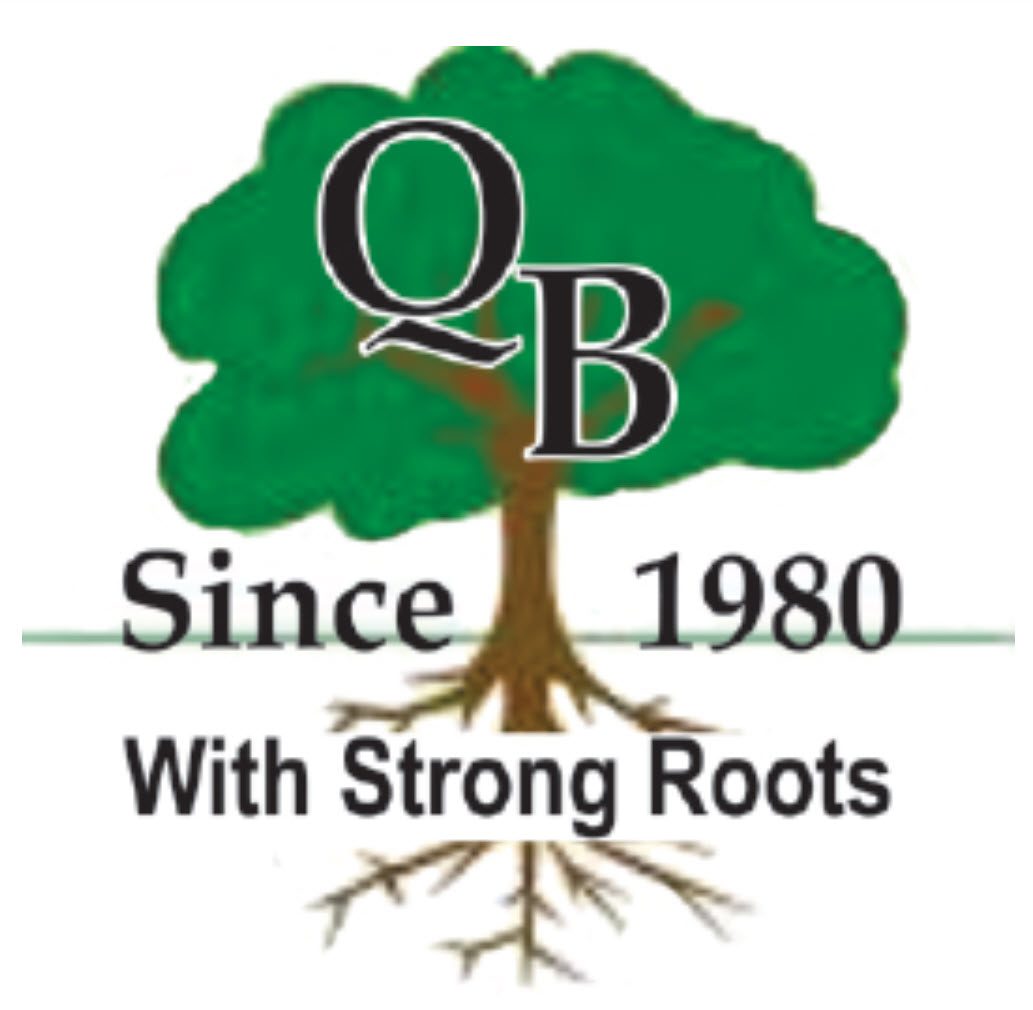- Great Moments in Genealogy
- Timelines and Chronologies: Secrets of Success
- Discovering the Lennox and Addington Archives
- Doors Open 2014
- Making the Most of the Canadian Census Records
- Building Personal Archives
- Researching at Queen’s University
- Researching at the Marilyn Adams Genealogical Research Centre
- Digital Images: Scanning, Editing and Preserving Your Photos
- What’s Beneath Your Feet
-
Great Moments in Genealogy
Quinte Branch Presentation
Article by John Carew
Photography by Georgette Green
Saturday, November 15, 2014 at the Quinte West Council Chambers was a different kind of presentation event than what most of our audiences are used to. Spurred on as a result of a speaker cancellation, Quinte Branch decided to have an open forum discussion about genealogy, led by members of our Executive Committee, but intended to involve everyone in attendance as participants. Guess what: it worked!
The only planned part of the afternoon involved two short sessions, starting with opening remarks by the Chair, which included a few brief announcements, sharing of some photos of a recent event honouring Pte. John Johnson, a veteran of the War of 1812, a few photographs and background stories about World War 1 participation by members of the Carew and Faulkner families, and reference to some salvaged glass plate negatives of photographs from the pre-war period, Camp Petawawa, 1912. The Chair then invited the assembly to introduce themselves and offer highlights and challenges about their research. Following a rather robust round of introductions and insights into everyone’s research
efforts and priorities, Bob Dawes provided the second planned session, a short talk on the seven golden rules of genealogical research. The Golden Rules talk (Start with yourself, Be organized, Interview your relatives, Stay focused on one family, Learn about surnames and origins, Join Societies and take courses, and make computers and the internet part of your toolkit) normally serves as the introduction of a longer Genealogy 101 presentation, but on its own, was very useful to the veteran researcher as a reminder as well as to the newer and less experienced in the crowd. Between Bob’s ideas brought out during his presentation, and the questions and concerns that were lingering and festering from the earlier round of introductions, we had a very dynamic and highly informative Q & A session to end the day, which had to be halted to allow time for refreshments. Nonetheless, several conversations continued in the spirit of the afternoon, almost to the point of making it touch and go for us to clean up and depart the premises by closing time at 4 PM sharp.
At our Saturday debrief at Tim’s following the Great Moments in Genealogy presentation, it was decided that we might want to do this again. The brilliance of that decision could be the coffee talking, but I suspect it was the coffee and the obviously welcome opportunity to share ideas and great moments in research. Go figure!!
PS: If you want to get a refresher on the Seven Golden Rules, download the Genealogy 101 course package on our website.
PPS: Merry Christmas!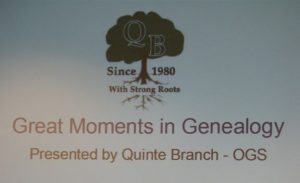
Timelines and Chronologies: Secrets of Success
Digital Presentation by Geoff Rasmussen
Article by John Carew
Photography by Georgette Green
Geoffrey D. Rasmussen graduated with a degree in Genealogy and Family History from Brigham Young University and has served as director and vice-president of the Utah Genealogical Association. He is a dynamic speaker on all forms of genealogy technology, and hosts the Legacy Family Tree webinar series. He has authored books, videos, articles, and websites, and plays a role in the development of the Legacy Family Tree software program. This seminar was recorded before a live audience in Anchorage, Alaska, at the 2013 Anchorage Genealogical Society. Using Legacy Family Tree software, Geoff Rasmussen demonstrated:
– Benefits of using a timeline in your genealogical research
– What a good timeline includes
– Methods of creating a timeline, and
– How to embed historical events into an ancestor’s timelineThe value of this presentation beyond sponsorship and explanation of Legacy and its features can be easily understood in the context of exposing the researcher to information which already exists, but in a fashion different from the standard displays used during the acquisition and assembly of information into family tree programs which has been found during the research process. We all tend to suffer from tunnel vision to some extent and the presentation of facts about a particular individual using an alternative display such as a timeline display and a chronology of events can be quite beneficial and can serve many purposes. In short, it wakes us up to other possibilities when trying to analyze data. A timeline display is present in most of the available family tree software programs but is generally provided as an alternate presentation format. Anyone using Ancestry is familiar with the timeline display as it is the standard display for each person in your Ancestry Tree. Legacy has embedded some additional features which can be incorporated into a person’s timeline temporarily to help with analysis of an individual’s lifespan, their personal and family experiences and significant world events which may have had an impact on their decision making, successes and failures.
The best recommendation to be offered to all researchers is to look at the timeline display in your current software and try the additional features which are provided, whether it is Legacy, Roots Magic, Ancestral Quest, or Family Tree Maker, or any others for that matter. Timeline is a very useful display, and we all know that each and every tool which we can master in the conduct of family research will eventually be of help, sooner or later.
This Legacy webinar presentation is free to view online here and the handout is free to download as well.
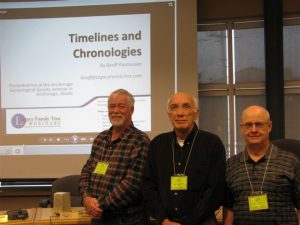
Executive members: Terry Buttler, Vice-Chair; John Carew, Chair; Bob Dawes, Database & IT/Indexing
Discovering the Lennox and Addington Archives
Article by John Carew
Photography by Lynn Heale
On Saturday, September 20, Quinte Branch kicked off the fall session of general meetings and presentations at the Quinte West Council Chambers in Trenton with a visit from a genealogy colleague from Napanee, Shelley Respondek. Shelley graduated from the University of Toronto in 2005 with a Masters Degree in Archival Studies and spent some time working at the Kingston General Hospital Archives before taking on a three-year appointment with the Red Deer and District Archives. In 2008, Shelley was selected to replace the retiring archivist at the Lennox and Addington County Museum and Archives in Napanee and has been front and centre and heavily involved in the upgrade and addition to their facilities in Napanee. The Museum and Archives recently celebrated its grand reopening 23 August 2014. Her presentation, in three parts, highlighted and showcased the major components and equipment in the new facilities delved into the myriad resources and publications for genealogical research, and closed with a how to primer on researching and discovering those hard to find any oftentimes overlooked nuggets of fact which enhance better understanding of the lives of our ancestors.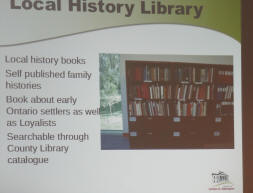
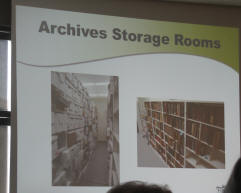
Shelley took full advantage of her PowerPoint slide presentation to show just how wonderful the updated surroundings are for work and research and included a number of slides depicting the new and improved storage and display features of the Archives. Her tips on how to proceed with research, amongst other things, emphasized the extensive photo and document collections.
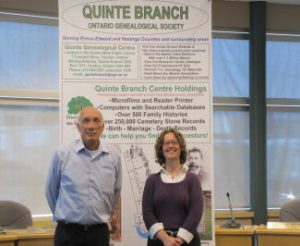
John Carew, Chair, and Shelley RespondekThanks to Shelley, we all gained a very special insight into the treasures that await genealogists and family historians alike at the Lennox and Addington County Museum and Archives. Do yourself a big favour and explore their website online, and then follow up with a visit in person to more fully enjoy the new facilities and what they have to offer. You won’t be disappointed!
Doors Open 2014 at the Quinte Genealogical Centre
Article by John Carew
Photography by Cheryl Levy
On Saturday, September 13, Quinte Branch participated in the Bay of Quinte Region “Doors Open” event at the Quinte Genealogical Centre. In the form of an open house from 10 am to 4 pm, there was a steady stream of the curious, friends of OGS members, current members, and some potential new members who were thinking of starting a family history project, or were in the early stages of discovering their past. Quinte Branch volunteers were on hand to answer questions, explain the roles and function of Quinte Branch and OGS, and show how to use our library research resources. Of particular note, one individual came from Peterborough to see our research library and hopefully find some ancestors in the process. She was not disappointed and spent a good part of the day working on the computer databases and perusing our publications to find numerous ancestral connections and supporting facts. She promised to return at some future date because there was more to be found and recorded than she could possibly manage in one visit. Like our Peterborough visitor, several people took this opportunity to visit our library to prepare themselves for future family history research initiatives.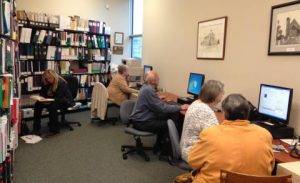
Using Library resources at the Quinte Genealogy Centre during Doors Open 2014As an added bonus, we had two courtesy calls at the library during the day. First, the Hon. Hugh P O’Neil stopped by to say hello and to discuss a number of things including future donation of the O’Neil family genealogy to our library. Later in the afternoon, Justice (Ret’d) George Inrig and his wife Elaine paid us a visit, and George presented Quinte Branch with a copy of his recently published limited edition autobiography, “Who Cares”.
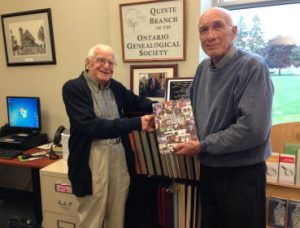
Justice (Ret’d) George Inrig and John Carew, Chair of Quinte Branch OGSEveryone who attended went away with our takeaway bag of pamphlets and tools to encourage and further interest them in genealogy and family history. I hope our guests found the day as informative and worthwhile as much as our volunteers found the time enjoyable and rewarding. Thank you to volunteers Debb Walker, Terry and Sharron Buttler, Cheryl Levy, Lynn Heale, Larry McQuoid and yours truly.
Making the Most of the Canadian Census Records
Article by John Carew
Photography by Cheryl Levy
On Saturday, 21 June, Quinte Branch held its final general meeting and genealogy presentation before the summer break. The digital presentation, made available to Quinte
Branch, courtesy of Millennia Corp and Kathryn Lake Hogan, focused on the Canadian Census events from 1851 to 1911.
We have all accessed these Census records in the course of doing our genealogical research, and I suspect that to a certain degree, most of us are well aware that while all of these records provide a standard and similar set of facts about respondents, each Census has its own set of variations based on Government of the Day information requirements. In her presentation, Kathryn provided us with a clear dissertation on what is common to all of these Census records, and what is unique to each. She used three family groups from her own research to illustrate how these similarities and differences actually play out in terms of real research. Through the use of these practical examples, Kathryn ably demonstrated the conundrum we have all experienced with these types of historical records: sometimes the Census facts recorded are not what we are expecting to find. Predictable and expected facts are usually present in good proportion, but surprises and respondent errors abound! It is what makes family history research so much fun.
The detailed handout which accompanied the digital presentation is a wonderful takeaway, and will no doubt prove to be a valuable asset time and time again. This presentation is highly recommended if you have a chance to see it. For more information about this presentation and the link to view a free preview: click here.
Membership Update:
Our Membership Coordinator, Lynn Heale, reminded us about the Partial Year Membership offer by OGS, which is available from June 1 to October 31 for $35.70. This allows you to join right away rather than waiting for the next calendar year. Don’t forget to join Quinte Branch for $10.
Membership in OGS runs for the calendar year (January – December). Individuals joining after October 31st will receive a membership for the next calendar year. For more information about memberships, click here.
Building Personal Archives
Article by John Carew
Photography by Georgette Green
On Saturday, May 17, 2014, Quinte Branch members and guests gathered to hear Stephanie Wright, manager of Timelines Research, speak on the subject of building personal archives with a presentation entitled, A Family Archive: Love Your Ephemera. The premise for and value of this presentation is the well-known fact that far too many amateur genealogists and family historians (me and a few others I suspect) become engrossed in the search for information and ultimately the documentation and populating of family trees, at the expense of taking proper care of the very documents, artifacts, photographs and ephemera discovered during the family history journey. The motivation to be gained from Stephanie’s talk was obvious and forthright: to continue or begin efforts to identify, organize and preserve those valuable assets that should be embodied in a personal family history archive. Luckily for those who attended the lecture, and for those curious enough to read this short article, she provided a Do It Yourself (DIY) handout which explains just how to approach this all-important task. It outlines and provides the salient details on how to proceed and create your archive in five logical steps: Gather, Sort, Identify, Store, and Digitize. Her 90-minute presentation, which kept our attention throughout, basically followed the thrust and content of the handout and was enhanced with several non-attributed anecdotes and examples of client research problem-solving. Those of us already committed to this genealogical undertaking were able to
mentally validate our current practices for archiving and perhaps learn a few new tricks, and the rest of us got a big leg up on how to start and proceed in the right direction.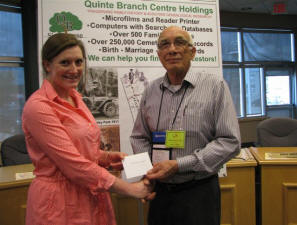
Stephanie Wright being thanked by John Carew, ChairFor those who may wish to further explore the slate of professional services offered, visit the Timelines Research website.
Researching at Queen’s University
Article by John Carew
Photography by Georgette Green
If you took in the April 2014 Quinte Branch Meeting on the 19th, Easter weekend offered a special bonus for those of us who were present for Nancy Cutway’s lecture on Researching at Queens’s University. Our decision to ask Nancy to come and speak to us was embedded in the question, “Does a university library hold anything of interest to genealogists?” Because family history transcends inter alia history, geography, sociology, political studies, religious studies and so much more, the answer is a big fat YES! After hearing Nancy’s views on the subject, there was only one conclusion to be had: any University with library holdings that support these academic fields of study is a treasure trove for genealogists. So, with that fact in hand, Nancy went on to give us a few details about what to expect, how to find it, where to find it, and how to prepare for the experience of
researching at Queen’s.
Of the several libraries at Queen’s, Nancy focused our attention on three of them, the Joseph S. Stauffer Library which is the main campus library, the Douglas Library which houses the W. D. Jordan Special Collections and Music Library, and the Queen’s University Archives which are housed at Kathleen Ryan Hall. A limited overview of what these libraries have to offer follows below.
The Stauffer Library holdings include Government documents, including some complete Censuses of Canada, Newspaper Collections, vintage and current, early Canadian journals, Fire Insurance Plans for communities with links to Library and Archives Canada, Ordnance Survey Maps of Ireland, circa 1835, publications such as Victoria County History (Counties of England), various and sundry publications about United Empire Loyalists, and far too many individual books and publications on topics of significance to genealogy to be mentioned here.
The Special Collections Library includes rare books, including early Canadian publications, the Edith and Lorne Pierce Collection of Canadiana, and much more. The Archives include, notably, the H. C. Burleigh Papers, covering research into Loyalist families.
If you think this is not enough in the way of specific mention of documents to peak your interest, there is more. Nancy provided our Quinte Branch OGS Library with a Catalogue of Newspaper Holdings in Queen’s University Libraries, prepared by her in 2010. In addition, she offered as a handout a partial listing of items of genealogical interest in Queen’s University Libraries, prepared for Quinte Branch OGS, and provided by her on April 19, 2014. This six page partial listing which covers all three libraries is available for download
by members as a PDF file. The link will be posted in the June issue of The Searchlight.
Before you run off to Kingston on a hunch Queen’s may have something to make your trip worthwhile, Nancy suggested that you do a little preparation and planning. This link
http://library.queensu.ca/ will enable you to search the libraries for clues about documents of interest to your field of genealogical search. You will also be able to find out more about the libraries from this site. In addition, this link, http://www.queensu.ca/encyclopedia/index.html provides a detailed history of Queen’s University, its facilities and buildings, and equally important, its people, past and present. This alphabetical listing about Queen’s will give you lots of background about the University and the Libraries you are going to visit, and more if you wish.
So, thanks to Nancy, Queen’s University up the road at Kingston, which we have all known about our whole lives, is no longer just an excellent university. It is a genealogical research destination! See you there!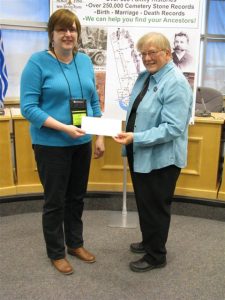
Cheryl Levy, Webmaster, thanked our April guest speaker: Nancy Cutway
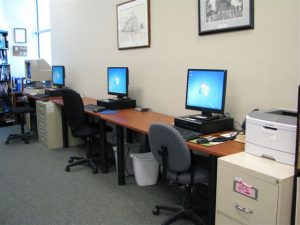
New computers for Quinte Branch Research Library
Researching at the Marilyn Adams Genealogical Research Centre
Article by John Carew
Photography by Georgette Green
Our Ides of March 2014 Genealogy Meeting at the Quinte West Council Chambers was a very successful double-header, combining a designated Annual General Meeting (AGM) for Quinte Branch OGS with a presentation about Ameliasburg’s very own Marilyn Adams Genealogical Research Centre (MAGRC) and the 7th Town Historical Society.
The AGM was called to order at 1 pm, the principal objective of which was to seek Branch approval of 4 Motions covering the 2013 Financials Audit, the proposed Budget for 2014, the 2013 Chair’s Annual Report to OGS, and the slate for the 2014 Branch Executive Committee. Each item on the agenda was presented by the Chair in succession, with each Motion read, moved, seconded and voted on by the members present. All motions were approved and carried.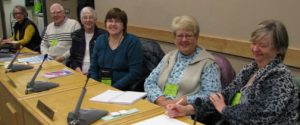
Barbara Dawes, Volunteer – Larry McQuoid, Treasurer – Lois Duggan, Social Hostess
Cheryl Levy, Webmaster – Debb Walker, Publicity – Debbie McDonald, Secretary.Following this short AGM for Quinte Branch, Bob Dawes introduced our guest speaker.
Diane Godbout is the sitting President of the 7th Town Historical Society, having taken over the reins last April from Ian Reilly. Diane is a graduate of Queen’s University and she held various managerial positions with Bell Canada over a 30 year period. She also served as Governor of Loyalist College for 6 years and was a Director of 7th Town from 2000 until her appointment as President of 7th Town Historical Society in 2013.
In her introductory remarks, Diane offered a short history of the 7th Town Historical Society which was formed in 1969 and the MAGRC which was established in 1994 at Ameliasburg in the City of Prince Edward County. The main topic of her presentation focused on the library holdings at MAGRC and 7th Town which are the treasure sought by family historians and genealogists who come from far and wide to conduct research. While she covered all of the major categories and types of research resources in their library, Diane made special emphasis on the significance of their 1200 family genealogies which have been donated over several decades, the value of CemSearch as a research tool for birth, death and cemetery information in the form of digital cemetery transcripts for our very large local community which shares this database, and the unique and very precious Hastings County Land Records and Abstract Books, including Deeds and occasional Wills for the lucky researcher.
Diane offered her views on the several particular advantages of doing research in our own communities, noting that there are many types of documents and records which have local origins and subject matter which is not available anywhere else or through internet sources. She made particular mention of the fact that they are in the midst of completing a GPS project for their cemetery list locations, and that they are soon going to tackle indexing of the Land Records for Belleville and Trenton. Following her talk, excerpts from the 2013 History Moments DVD were shown, featuring the Marilyn Adams Centre and the life of Marilyn Adams. During the Q&A which followed, Diane fielded many questions on her presentation, the MAGRC and 7th Town. Diane was thanked by the Chair of Quinte Branch for her very informative presentation about one of the Bay of Quinte’s local and highly valued historical and genealogical resources.
Click here for Marilyn Adams Genealogical Research Centre website Also check out: 7th Town Historical Society and Quinte Kin.
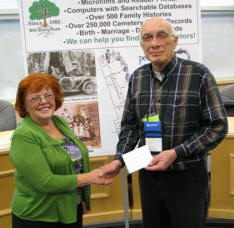
7th Town Historical Society President, Diane Godbout was thanked by
Quinte Branch Chair, John Carew for her informative presentation.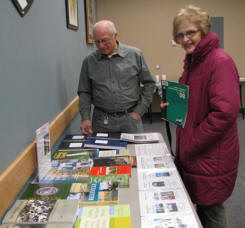
Quinte Branch offers a variety of books and CDs relevant to local research,
including Quinte cemetery transcriptions at our Resource Table.
Digital Images: Scanning, Editing and Preserving Your Photos
Digital Presentation by Geoff Rasmussen (with permission)
Article by John CarewOn February 15th at the Quinte West Council Chambers, our presentation of things genealogical took a bit of a turn and a twist. For the first time, Quinte Branch OGS opted for a webinar event, partly for a change of pace and partly to evaluate the trend and effectiveness of this format in our own backyard. This premiere digital video and audio lecture was attended by about 45 members and visitors, all of whom either were practicing the skill sets involved and were looking for some tips to improve their levels of expertise or were wanting to get involved in the process and hoping for a leg up before they started. Based on feedback during and after the presentation, no one went away disappointed! Geoff Rasmussen graduated with a degree in Genealogy and Family History from Brigham Young University and has served as director and vice-president of the Utah Genealogical Association. He is a dynamic genealogy speaker on all forms of genealogy technology, and as host of the Legacy Family Tree webinar series, has spoken virtually to nearly 100 different countries. He recently received the Distinguished Presenter Award at the prestigious RootsTech conference in Salt Lake City. His biographical summary is spot on as evidenced by his presentation which was both very informative and easy to follow. A handout available to attendees provided a worthwhile set of notes and reminders of the major elements of Geoff’s lecture. The subject matter included the basics of digital imaging, a review of terminology and the fundamentals of scanning, editing and preserving old and new photos, including pitfalls to avoid and a number of sound recommendations on how to approach each task. After a considerable number of “how to” explanations with lots of graphics to demonstrate the right, wrong, and better, best possibilities, we conducted our own Q&A session before calling it a day and finishing off the event with coffee, cookies and conversation.
If I am any judge of the success of this event, our members should expect more of this type of high-quality presentations in the future. A sensible balance of webinars and live presentations will expand our choices of topics and presenters to make the most of our learning experience. Here’s hoping!!
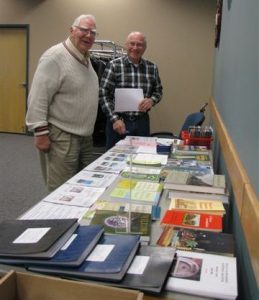
Larry McQuoid & Rod Green checking out our Resource table
Photo by Georgette Green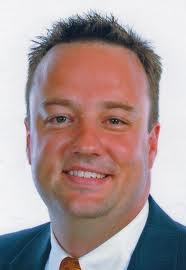
Geoff Rasmussen, host of Legacy Webinars
Check out more webinars here
Crouse-Wanamaker Lecture
What’s Beneath Your Feet
Article by John Carew
Photography by Georgette GreenOur 2014 series of presentations on genealogy and its companion interests were kicked off on 18 January at the Quinte West Council Chambers with the annual Crouse–Wanamaker Lecture, tying together the history of our very own Quinte Branch of the Ontario Genealogical Society with the current issues and revelations of the day.
The Chairperson, John Carew, extended thanks on behalf of the Branch to Tracey Cuddington, Mary Culloden and Clare Westheuser for their contributions to our genealogical efforts, and who have recently withdrawn from their positions as committee coordinators. We wish them well and look forward to their continuing support and interest in our activities and undertakings as Branch Members. He also informed the audience that Marilyn Harry is doing well after her hip surgery and that she hopes to be back in fighting shape as soon as possible.
The Chair then turned his attention to the Crouse-Wanamaker Lecture with a few words of history and reflection. Gordon Crouse was our first Chairperson in 1980 when the Branch was formed, and furthermore was the instructor for the initial cadre of 26 Charter Members whose training he oversaw in the fall of 1979, when 32 local citizens expressed a desire to get some formal education to enhance their family history research aspirations. Most of that genealogy class joined Quinte Branch as Charter Members, and many others followed. Loral and Mildred Wanamaker were accorded Honorary Membership in recognition of their longstanding involvement in genealogy and local history such as their early involvement in the 7th Town Historical Society. From this small group of well-motivated budding genealogists and with the leadership of Gordon Crouse and the inspiring experience of the Wanamakers, Quinte Branch flourished. Rodney Green, an original member of the Branch, and first Treasurer is still serving the Branch today in fine fashion in
our Research department. We owe them all a lot for their foresight, dedication to the Branch and commitment to genealogy. Bravo!
The Chair then introduced the guest speaker, Orland French, local author and former journalist with the Kingston Whig Standard, the Ottawa Citizen and the Globe and Mail, who provided us with some insights to his recently released book about the geology of Prince Edward County, entitled Wind, Water, Barley and Wine. His presentation on this subject, “What’s Beneath Your Feet?” was accompanied by a reminiscence about his uncle, Pte. Oscar French, who gave his life during WW1 at Vimy Ridge, and whose story will be the subject of the next book published from the desk of Orland French.
Orland devoted the bulk of his presentation to the world history backdrop of the emergence of Prince Edward County as a glacially ravaged landscape, rising out of the depths of the Laurentide Glacial Ice Sheet melt, which occurred approximately 14,000 – 13,000 years ago. Once the melt excess had found its way to the Atlantic Ocean and the shores of Lake Ontario’s larger predecessors had narrowed to relatively current positions, Prince Edward County was now part of the Ontario landscape. While home to about 25,000 people, “the County” is better known for its unique geology and visual grandeur, of which there are several features and splendors, and perhaps less so for excesses of opportunity. stripped of much of its topsoil by the glacial rub, the land has been used and continues to be used in our time to advantage where possible, but “the County” provides for such a wonderful combination of onshore and offshore activities, that few of us would fault the Laurentide Glacier for what it left behind for us to cherish.
The book, Wind, Water, Barley and Wine, offers a wonderful opportunity to learn about the place we live in or what is a frequent destination for the rest of us, its birth as present-day land mass instead of aqua sub-structure, and considerable insight as to what we are able to appreciate and take advantage of as a place to call home, to play, to work and enjoy. That would be “the County”!
Check out Orland’s website here.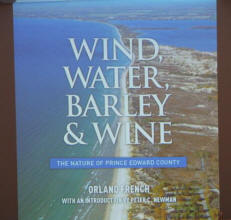
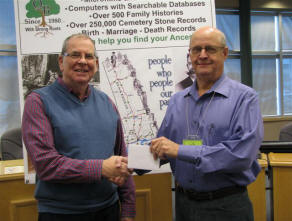
Guest speaker Orland French is thanked by Bob Dawes
-
